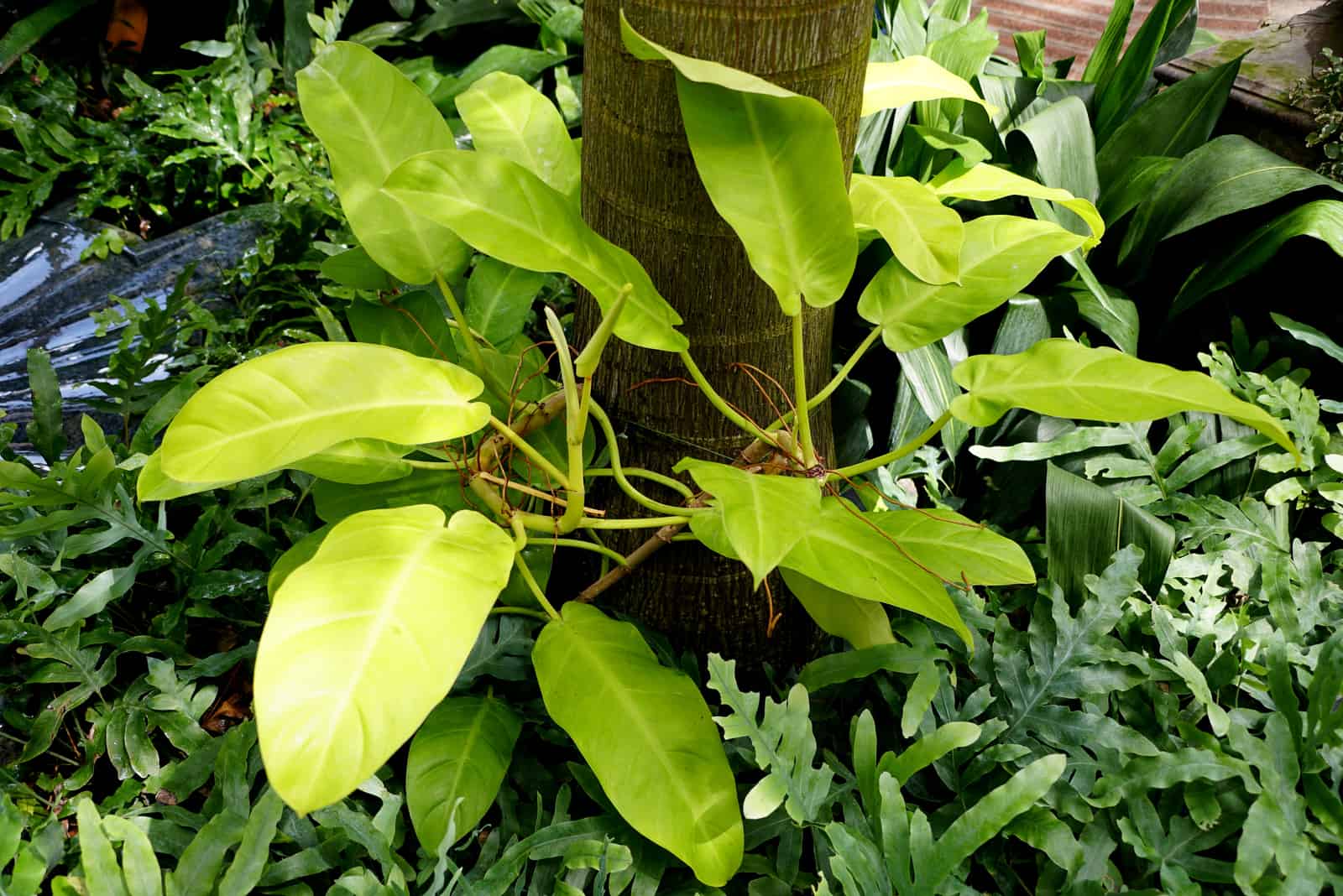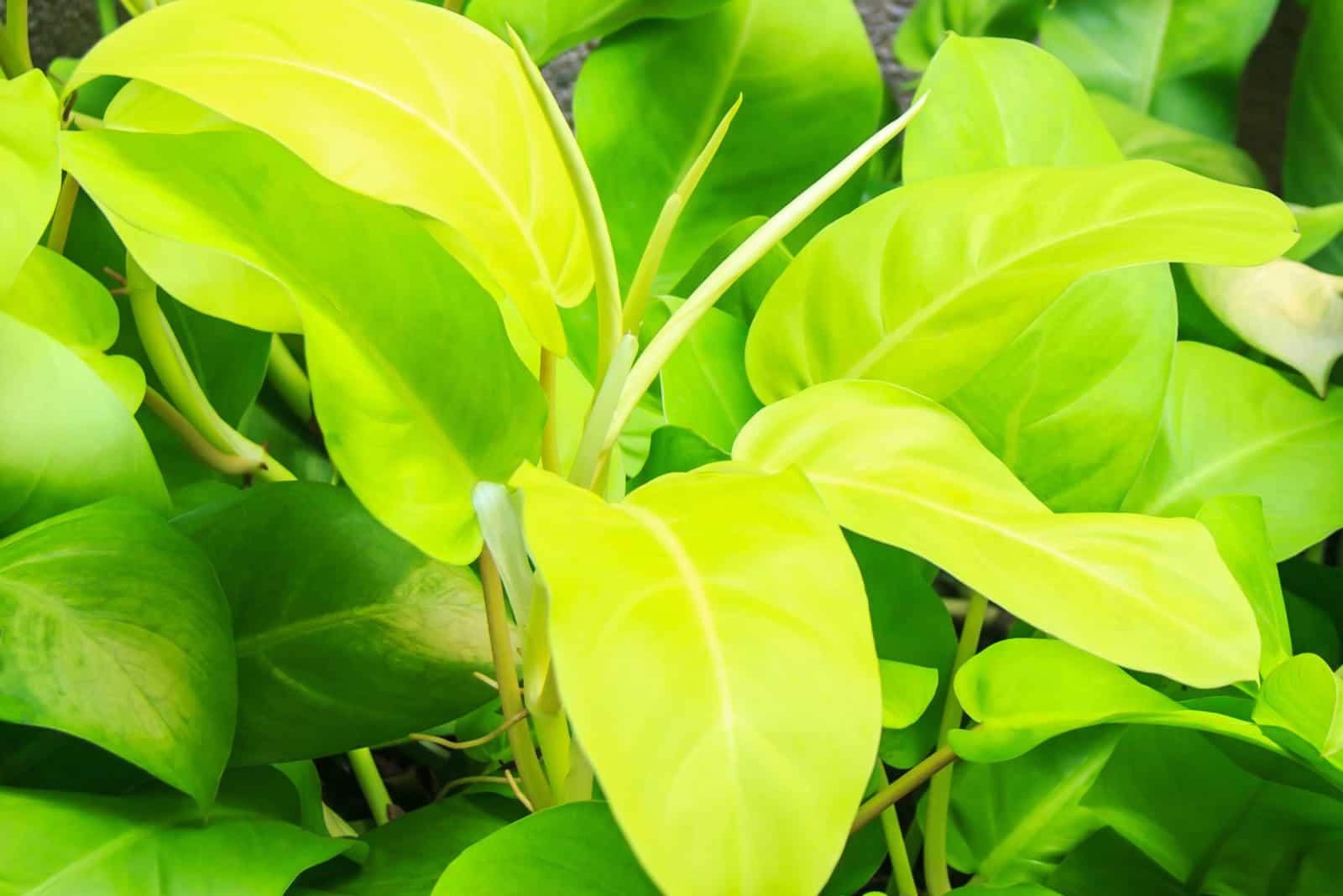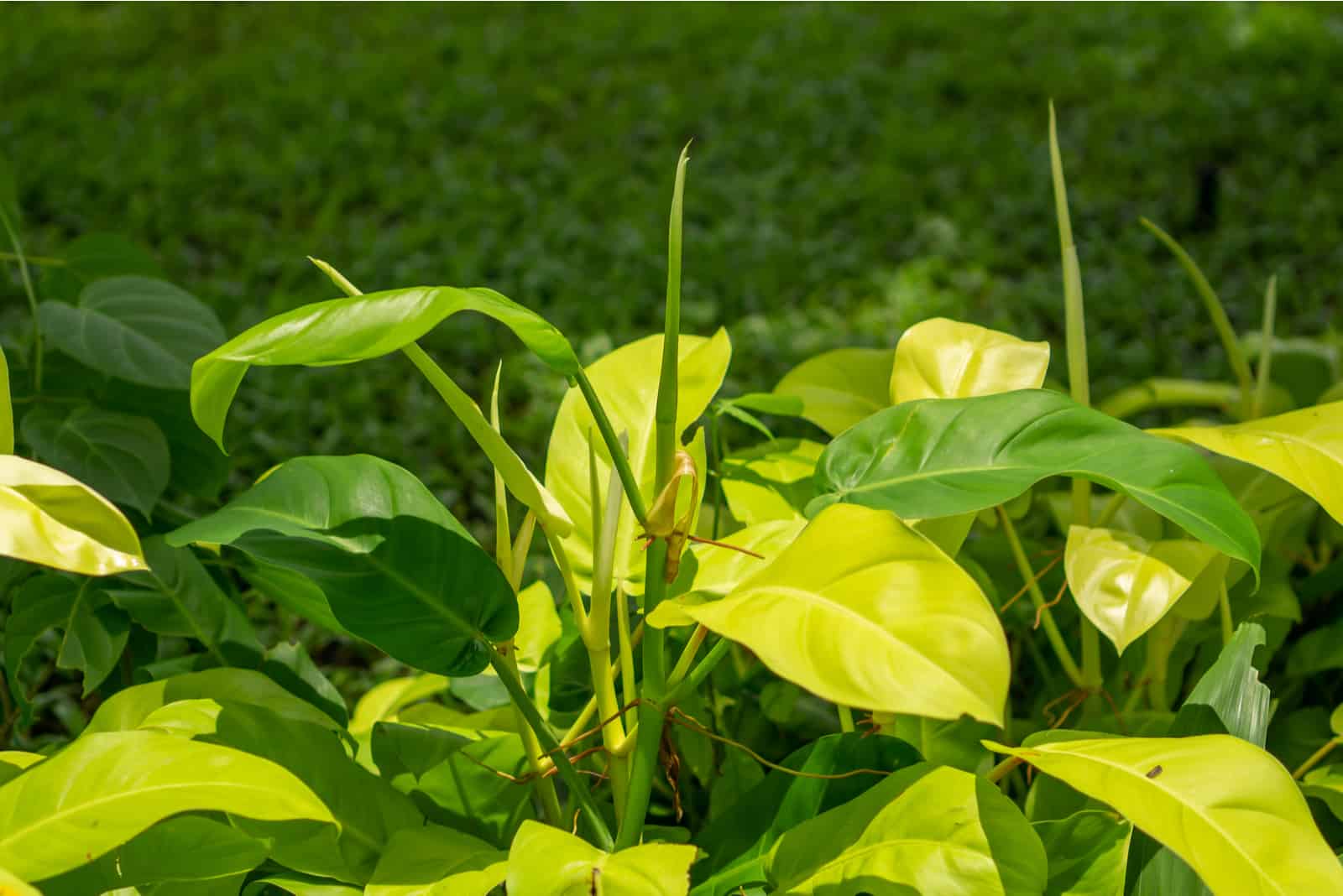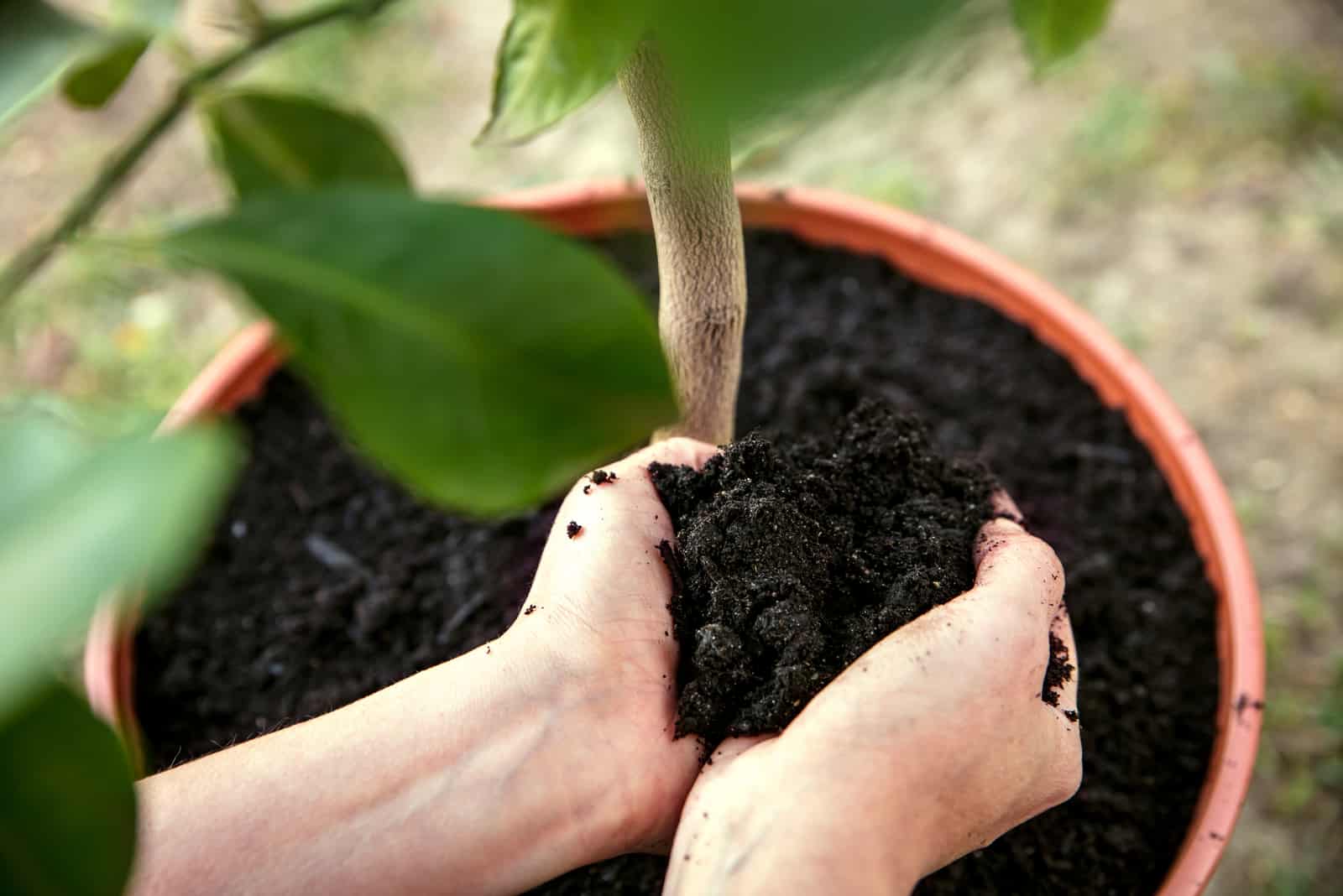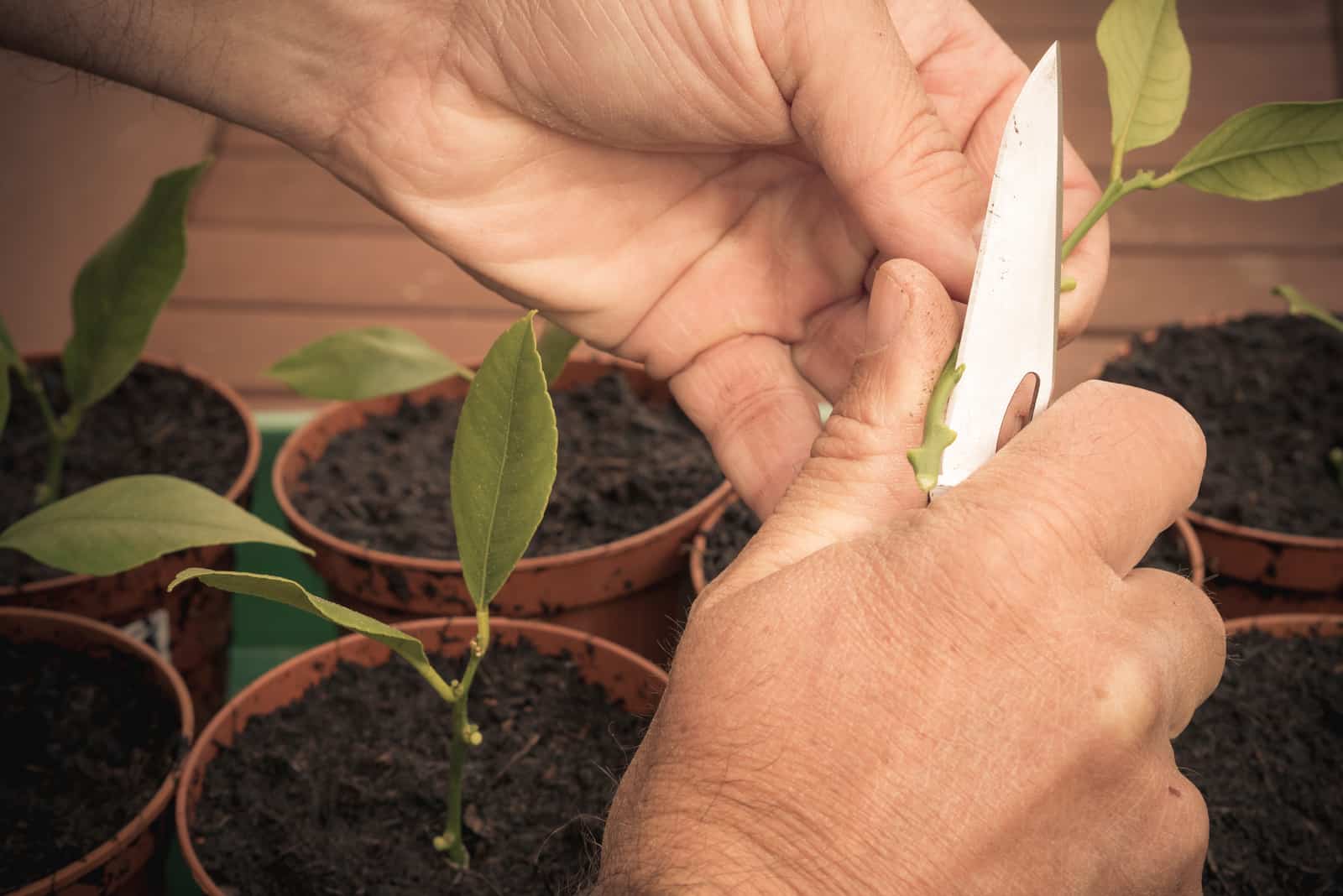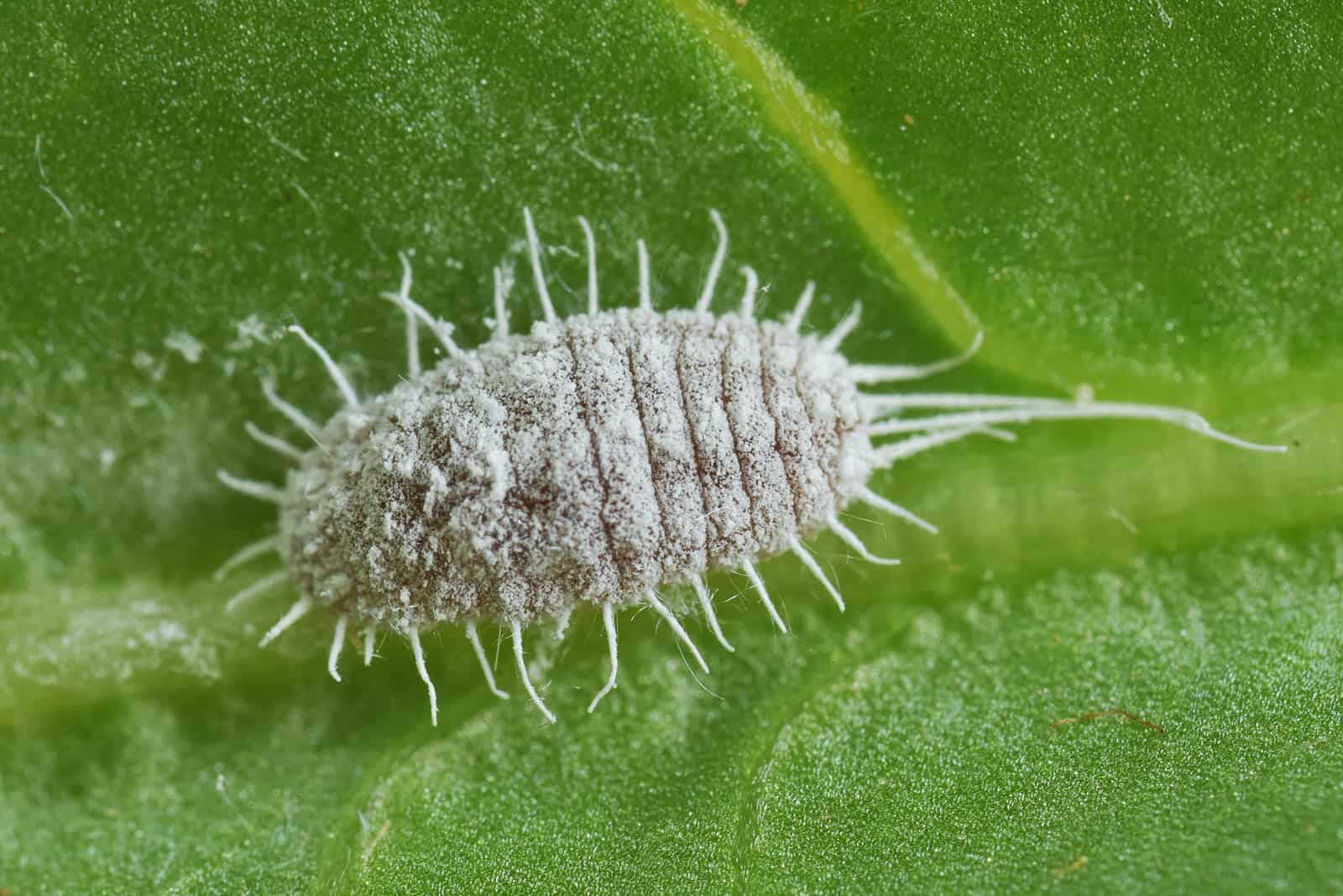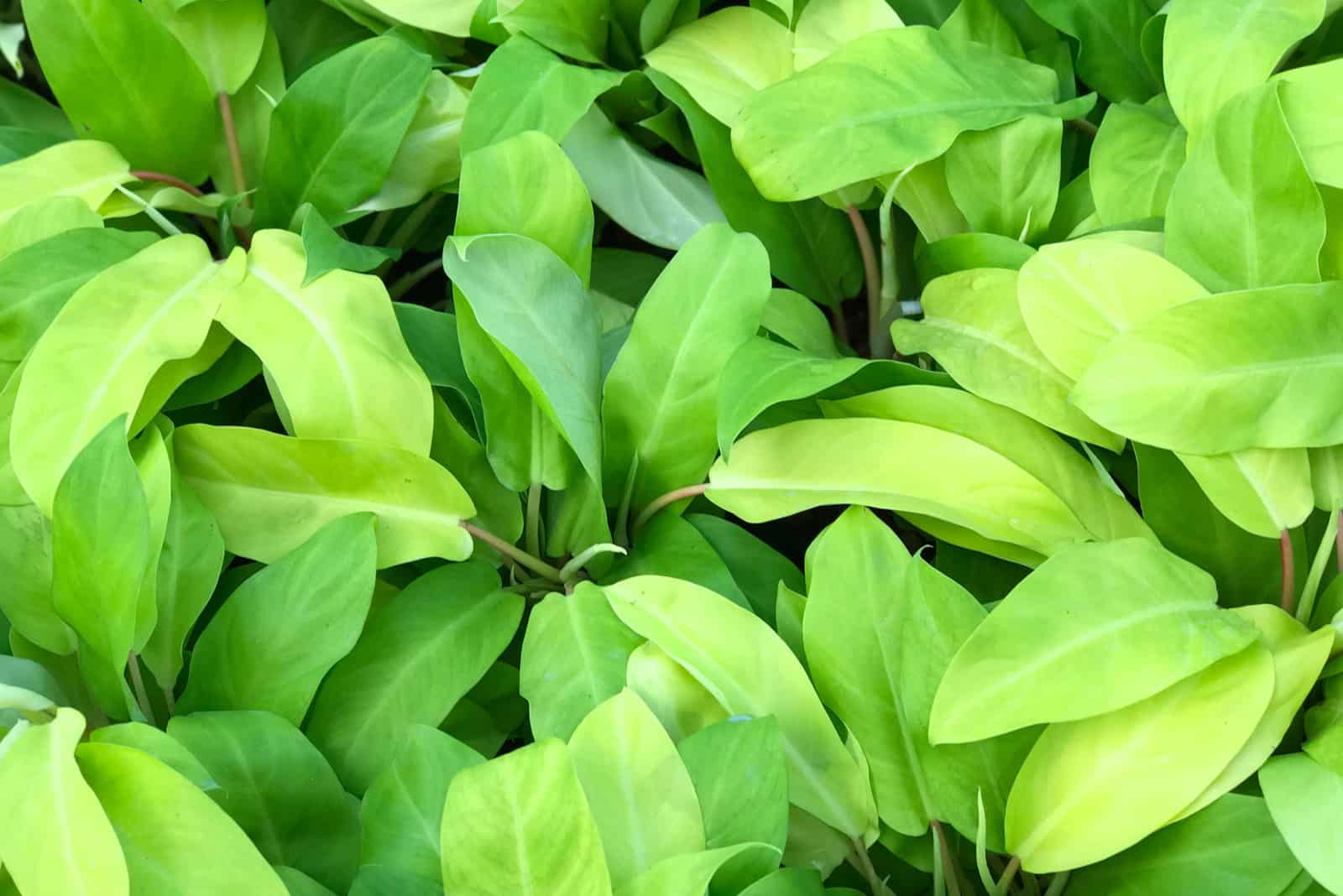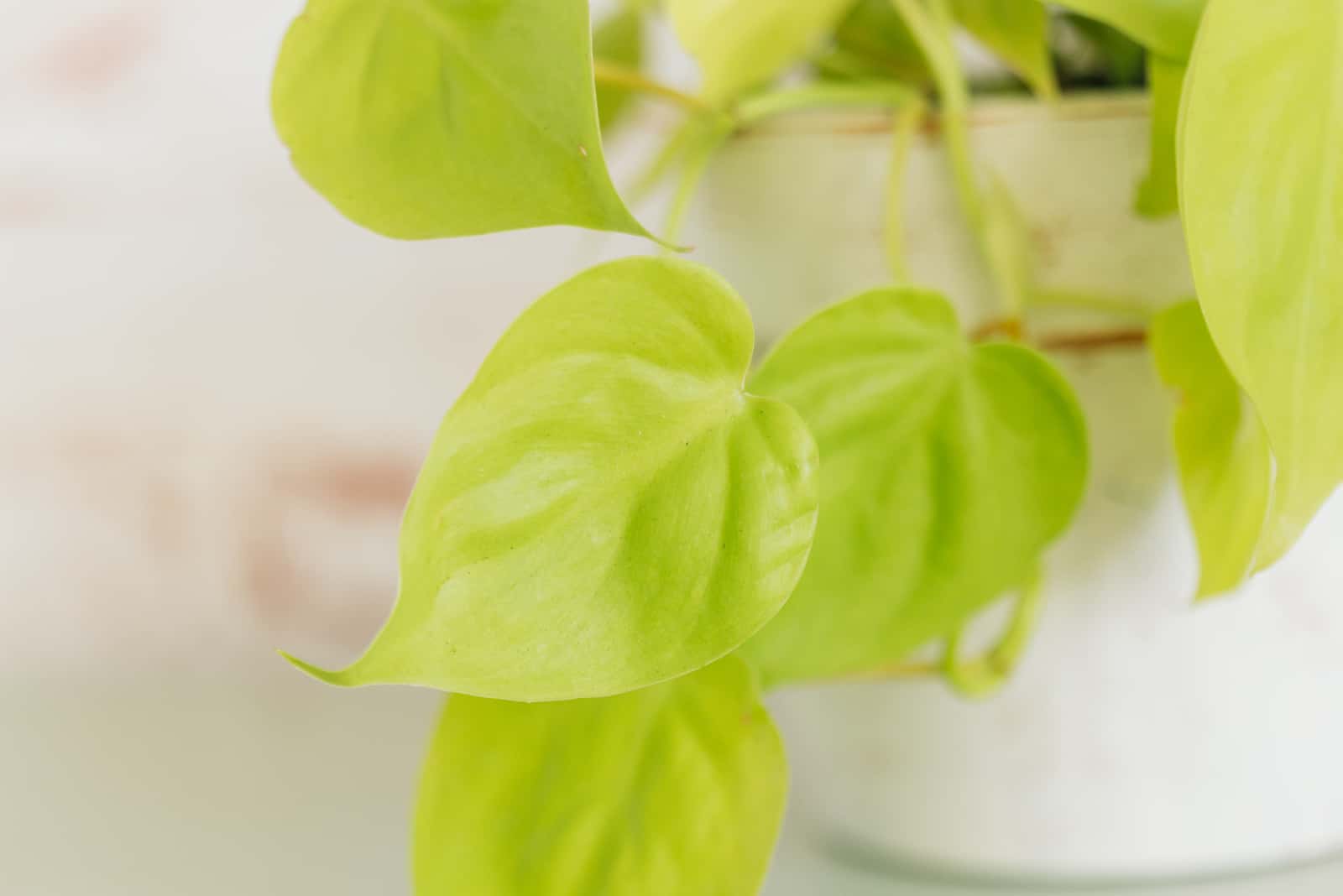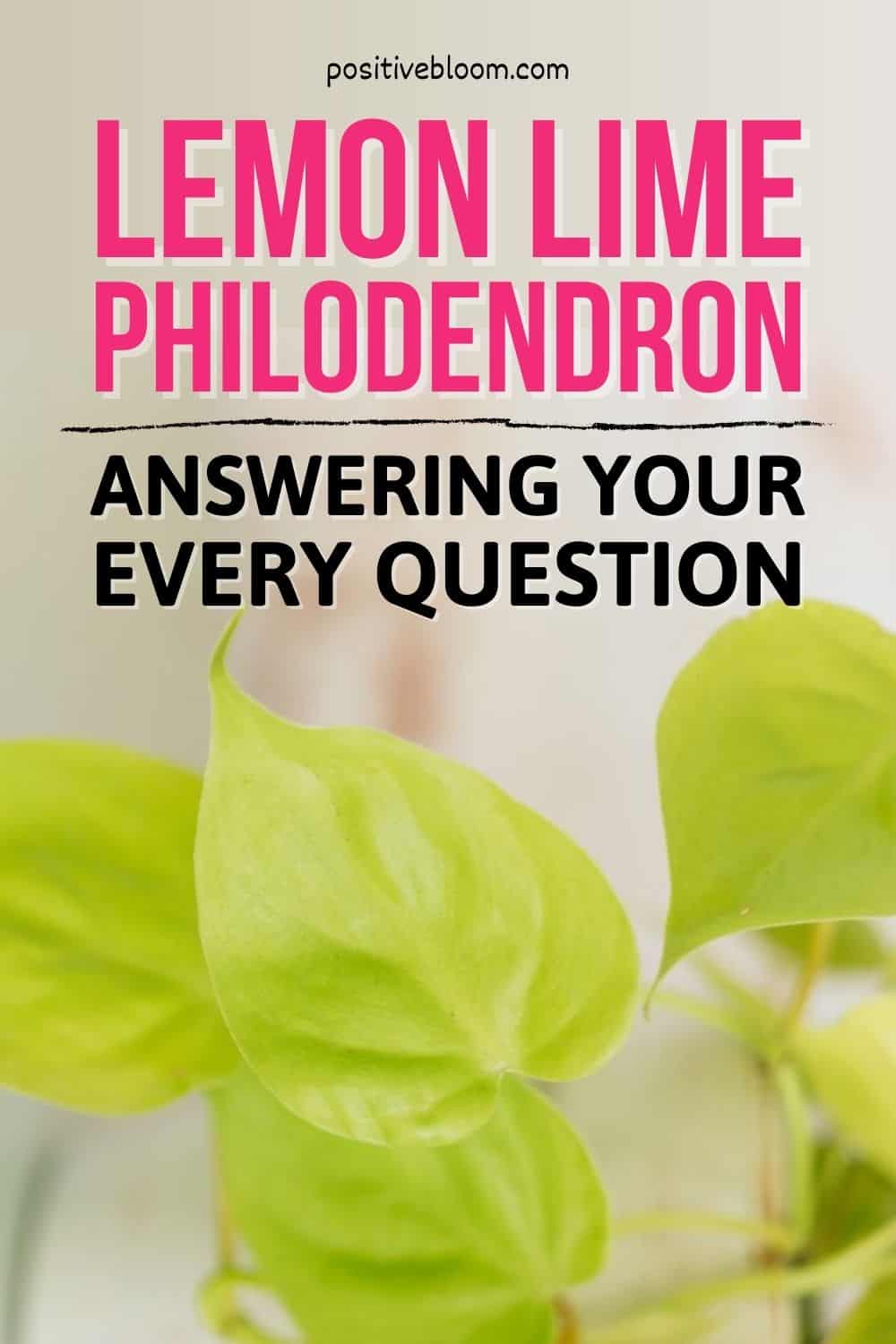The lemon lime philodendron is perfect for vintage and modern home decor. This houseplant is relatively easy to care for, so you can also use it to brighten up your workspaces.
Before we get into a detailed care guide, here’s some basic information:
[table id=76 /]Even though the Lemon lime philodendron is toxic and may cause several issues if ingested, you can still enjoy its unique foliage if you put it somewhere out of reach, like on a flower shelf.
This article brings you some fantastic tips and tricks for Philodendron lemon lime care. This variety is low-maintenance, and you only need to meet its light, water, and soil requirements for perfect foliage.
However, we bring you a detailed care guide, so you’ll know what to do if something goes wrong.
Let’s get going!
Lemon Lime Philodendron Care
I know we’ve all had this trouble at some point: we’ve bought a perfect hanging basket, but we don’t know what to plant in it.
Let me put an end to your worries! Lemon lime philodendron is the perfect choice as it is low-maintenance and can brighten up every space with its brightly-colored foliage.
Also, it will get along quite nicely with your philodendron Florida ghost as they have the same needs, and their difference in looks only accentuate their respective features.
Let’s take a look at its care guide!
Light
Philodendron plants are native to the Amazon rainforest, and the best thing you can do for your lemon lime philodendron is to mimic those conditions.
Therefore, don’t expose your Philodendron ‘Lemon lime’ plant to direct light as it can cause sunburn. Put it in a spot where it can receive bright indirect light, and you won’t have to worry about having a leggy plant.
However, Lemon lime philodendron can also survive in low light conditions, but it will grow slower, and its colors won’t be as bright.
Remember, the key to a gorgeous philodendron is giving it enough light but still keeping it away from direct sunlight as this can lead to sunburn and wilting of the foliage.
Water And Humidity
A Philodendron lemon lime is a tropical plant, and as such, it likes being watered. However, overwatering is a big issue with philodendrons as not many people know that moist and wet soil are not the same thing.
Philodendrons don’t like to be drowned in water; I mean, who does?
Water the philodendron at the soil level once the topsoil feels dry to the touch. Always allow the top half of the soil to dry between waterings to avoid root rot and other fungal diseases.
However, not every philodendron lemon lime requires the same amount of water all the time. You should monitor the weather and light conditions and adjust your watering accordingly.
If your philodendron doesn’t receive plenty of indirect sunlight, it should also receive less water. Also, plants generally need more water during their growing season than in dormancy, so you should water this philodendron less in winter than in the summer months.
Humidity
Lemon lime philodendrons don’t have anything against the average home’s humidity, but they do prefer higher humidity levels, and they will show their gratitude by producing more majestic foliage.
You can increase the humidity in three ways: misting, the pebble tray method, and using humidifiers.
Our favorite method is the pebble tray method, as this is safer than misting and cheaper than buying humidifiers. This way, you won’t have to invest extra cash into your philodendron care, and you don’t have to worry about making it ill.
Climate And Temperature
Philodendrons are tropical plants, and they like tropical climates, including warm temperatures and high humidity levels.
The optimal daily temperature is between 65 and 80 Fahrenheit (18-27 °C) with somewhat colder nights, around 55 °F (13 °C). Colder temperatures can lead to stunted growth, so you should be extra careful in winter.
Philodendrons aren’t delicate flowers that you need to handle with extra caution and care, but they still don’t like to be exposed to sudden temperature changes and drafts.
Soil And Fertilizer
Philodendron ‘Lemon lime’ is a cultivar with a specific soil preference. It likes acidic to neutral substrates with a pH level between 5.0-7.0. The medium needs to be loose, moist, and well-draining, and if you don’t have an aroid potting mix at hand, you can create one yourself.
Add some perlite and peat moss to your favorite soil mix to create a soil with good drainage and moisture retention.
Also, you shouldn’t add sand to the mixture. It improves the drainage but is also really dense, and it doesn’t leave enough space for the development of the philodendron’s root system.
You can always refer to a soil moisture meter to help you create perfect growing conditions for this philodendron.
Fertilizer
It is essential to know when exactly you should feed your plant. The basic rule is to provide plant food during the growing season and quit fertilizing when the plant enters dormancy.
The Philodendron ‘Lemon lime’ is just like any other plant, and it likes to be fed once a month in spring and summer, when it is actively growing.
You can use an all-purpose liquid fertilizer, diluted to half-strength, to avoid over-fertilization and fertilizer burn.
When the plant enters dormancy, you shouldn’t stop fertilizing suddenly. Plants’ growth slows down, but they still need nutrients. You can keep feeding your plants every other month, and this way, you will enrich the soil but avoid fertilizer burn.
Repotting
Lemon lime philodendron is a fast-growing plant, and it needs to be repotted once or twice a year. You will know your philodendron needs to be repotted once you see the roots crawling through the potholes or rising through the soil.
However, you should repot your philodendron plant at the beginning of its growing season, when you start to notice new growth of foliage. Repotting philodendron lemon lime in early summer has many health benefits for the plant and reduces the risk of stunted growth.
When repotting, choose a container larger than the previous one, but not too big; large pots can lead to water clogging and root rot, and no one wants to deal with those issues.
Also, ensure that the pot has draining holes so that the excess water doesn’t linger.
And finally, fill the pot with a fresh, well-draining medium, and plant the philodendron.
Finally, consider staking this plant on a moss pole, bamboo trellis, coir pole, or some other alternative to moss poles and admire its magnificence.
Pruning And Cleaning
Pruning is another essential part of the care for this heartleaf philodendron. Whenever you notice burnt or discolored foliage, you should cut it off.
A yellow or brown color may indicate that your plant is suffering from a certain disease, and the best thing to do is to remove the afflicted parts.
Also, dead or dying leaves don’t just mar the beauty of your philodendron plant, but they also drain energy from the plant.
You can prune philodendrons as close to the stem as possible to stimulate their growth. You can also cut off some leaves if your plant doesn’t fit into the place you chose for it or if it grows leggy.
Cleaning
Cleaning philodendrons is just as important as pruning them. These plants have large foliage, perfect for collecting dust. Depending on where you keep it, you might even need to dust the plant daily.
But whenever you do clean it, keep in mind that frequent wiping of the philodendron’s leaves with a wet cloth can lead to leaf spot and other fungal infections if you don’t let the foliage dry between wiping.
If you don’t feel like wiping and then drying the foliage, you can just stick with wiping them and letting them dry on their own. This increases the humidity for your plant’s foliage, so you don’t need to have a pebble tray or humidifier at hand in this case.
However, if you have already assembled the pebble tray, make sure that you dry the leaves after wiping, so that they don’t get infected with fungal diseases.
Propagation
The easiest and probably the best method of propagating philodendrons is by stem cuttings.
Choose a healthy stem with plenty of leaf nodes and cut it with sterilized scissors, so you don’t transfer any bacteria onto the plant.
You can propagate either in water or in soil. Propagation in water works faster, so we often choose this method. All you need to do is put the stem in a vessel filled with water and wait until it develops roots.
It might take some time, so don’t forget to change the water every week! After seeing that the root system has developed, you can plant your philodendron plant in a pot.
Before I forget, remember to remove the leaves that are entirely under the water, as otherwise they will only rot and contaminate your water.
When propagating this philodendron variety in soil, you just need to fill the pot with fresh and moist, well-draining potting soil and plant the stem into the mix.
Also, don’t be surprised by the color of the new leaves. They might be pinkish-yellow or brownish when young, but older leaves will still have their signature color, believe me!
Here are some tips and tricks for successful propagation:
Common Issues With Philodendron ‘Lemon Lime’
Now that you know that philodendron plant care is not demanding, we can look into some common issues that this plant encounters.
When we talk about issues, we usually mean pests and diseases, but problems with watering are becoming a significant issue too.
The term “tropical plant” brings associations to people’s minds that are not always correct, and we’re here to bust those myths!
Pests
The most common pests that attack philodendrons are mealy bugs, spider mites, and fungus gnats.
You need to deal with them immediately, before they can inflict severe damage to your plant. First, you need to isolate the infested plant from the healthy ones.
Then, if the infestation is limited to specific parts of the plant, you can try and pick the bugs off one by one or remove them with a strong spray of water. You can also use alcohol and a cotton pad, but be careful not to touch the plant as it can have a bad reaction to the alcohol.
Finally, if nothing seems to be working and the infestation is only spreading, use pesticides. Neem oil and insecticidal soaps have never failed me!
Diseases
Philodendrons frequently suffer from root rot and Erwinia blight. The good news is that these diseases are easy to prevent.
Root rot is caused by overwatering, so you just need to ensure that you only water your plant when the topsoil is dry. It also requires proper air circulation, so leave some space between it and your Philodendron birkin or Brasil.
Erwinia blight is a bacterial infection that attacks plants’ leaves and stems, and you need to use sterilized equipment to prevent it.
In both cases, you need to cut off the infected parts as soon as possible and repot the plant into fresh soil.
Underwatering
Philodendrons are not succulents, and you need to keep the soil moist for them to be healthy. Underwatering is a big issue, and it can destroy your plant.
If you notice brown leaves that are withering, it might be a sign that your philodendron needs more water.
However, you can’t just splash water on it and call it a day. You need to start watering it regularly, keeping the soil moist at all times.
Once your plant has had time to recover from the stress caused by underwatering, you can start checking the soil and watering the plant only when the topsoil feels dry.
Remember that aroids and tropical plants aren’t drought-tolerant, so you need to maintain the moderate moisture level of the soil. Also, they aren’t aquatic plants, meaning that they cannot survive in wet soils.
Overwatering
We have all overwatered our plants at some point. The important thing is that we can learn from it and not allow it to happen again.
The best thing to do to avoid overwatering is to wait until the topsoil is dry and only then water your plant.
However, if you notice the foliage is more yellow than usual, it is a sure sign that your plant has been overwatered. Too much water leads to fungal infections, and we want to avoid them at all costs.
The best thing to do with overwatered plants is to repot them using a fresh potting mix and then start watering them properly.
Over-fertilization
Over-fertilization and sunburns are also serious issues that may cause severe damage to your plants.
If you notice that the topsoil is crusty and white, it means that the fertilizer salts have accumulated. This can lead to root damage and fertilizer burn on the foliage that has become yellow or brown.
You can solve this by water flushing or repotting. If you choose to flush the soil, you need to put the pot in a sink or a bathtub and slowly irrigate it with water.
Measure the pot’s volume and use four times more water, allowing it to drain through the potholes.
Sun Exposure
Placing this philodendron plant where it can get the right amount of sunlight is crucial. If this plant doesn’t get enough light, it will grow leggy, and you will have to spend the entire day pruning and shaping it.
And why do that when you can simply put it in a bright spot with plenty of indirect sunlight to avoid the legginess?
On the opposite side of the scale, we have sunburns. Leaving your philodendron lemon lime exposed to direct sunlight will undoubtedly lead to sunburns.
You can easily recognize sunburnt leaves: they start drooping and turn brown. If this happens to your plant, you need to prune the damaged leaves and move the plant to a spot that fits its needs better.
Fun Facts About Lemon Lime Philodendron
Now that you know how to care for this unique plant, it’s time to look into some interesting facts.
In this next section, you will learn some things about this plant’s history and its appearance. Also, we have been asked many times, “What is the difference between the Philodendron ‘Lemon lime’ and the Neon pothos,” so we’ll also teach you how to differentiate between these two species.
History
The Philodendron hederaceum ‘Lemon lime’ has many common names: Philodendron ‘Lemon lime,’ Lemon lime heartleaf philodendron, Sweetheart vine, and many more.
The philodendron genus belongs to the Araceae family, and here’s an interesting legend of the discovery of the Philodendron ‘Lemon lime.’
Captain William Bligh discovered the Lemon lime philodendron in the 18th century. After the mutiny on his ship, the Bounty, he ended up in the Caribbean. The story goes that he liked this philodendron so much that he took it to England, where it was cultivated and observed by botanists.
After that, the stem cuttings were exported to Florida, where it was cultivated on a larger scale and sold in markets.
Philodendron hederaceum ‘Lemon lime’ doesn’t look the same during different parts of its life cycle. That is why it was named so many different names throughout history. It was known as Philodendron deviatum, oxydatum, micans, harlowii, and acrocardium.
However, all these names have gone into oblivion, and the Philodendron ‘Lemon lime’ is now called the Philodendron hederaceum.
Flowers And Foliage
The foliage of this philodendron doesn’t have many variegations. Young foliage is brown or pink-yellow, but as the plant gets older, it changes to a lime green that brightens our offices and living rooms.
Also, the care guide for philodendron Gigas is virtually the same, and its large, velvety leaves with yellow spots complement the lime green foliage of this philodendron perfectly.
The foliage contains crystals of calcium oxalate, which cause diarrhea, vomiting, skin irritations, and burning of the airways if they are ingested.
We all need to be careful around these plants and have to make sure that our children and pets don’t come into contact with them. And that’s why flower shelves exist!
The Lemon lime philodendron usually doesn’t bloom, but you may notice tiny pearls if you’re lucky. They don’t last long, so be sure to take a photo as soon as you spot them.
Philodendron Lemon Lime vs Neon Pothos
Philodendron ‘Lemon lime’ and Neon pothos are almost indistinguishable, but there are some features that can help you to distinguish between these two varieties.
Both of these varieties have brightly-colored foliage, but their shape and texture can help you to decide which is which.
The Philodendron has smooth, heart-shaped foliage that is more rounded than the textured leaves of the pothos streaked with veins.
The Neon pothos has thicker aerial roots, and its new leaves are green, whereas the foliage of a Philodendron ‘Lemon lime’ is usually pinkish-yellow or brown.
You Asked Us
Many of our readers have asked us questions about the Lemon lime philodendron. We have chosen to reply to the following questions as they were the most common and most beneficial ones.
Why does my Lemon lime philodendron have black edges?
Black edges and dark spots can be a sign of leaf spot disease. They can also be symptoms of other fungal and bacterial infections, such as leaf blights.
When you notice black edges on your plant, you need to separate it from the rest of the plants so that the infection doesn’t spread.
After that, prune the infected leaves, and ensure you meet their light, water, and soil requirements.
How can you tell when a Lemon lime philodendron is healthy?
A Healthy Lemon lime philodendron is not drooping and leggy. The color of its foliage is lime green, and they are not soft to the touch.
If the leaves are soft, drooping, brown, or more yellow than green, these are the signs that something is wrong with your plant.
In our section “Common issues,” you will find exactly what soft or brown foliage signifies and how to deal with these issues.
What are the benefits of a Lemon lime philodendron?
A Philodendron lemon lime filters the air and improves its quality by removing the toxins, such as formaldehyde, that are prevalent in most homes.
They bring a tropical touch to your home, improve the overall decor, and bring color to your office, library, or reading room.
To Sum Up
Now is the time to review everything we have learnt so far.
The Lemon lime philodendron is an extraordinary tropical plant that doesn’t require much maintenance, making it a perfect indoor plant for beginner gardeners.
You need to keep it in a bright spot and not allow the soil to completely dry in between waterings, this prevents stress which makes the plant more susceptible to pest infestation and diseases.
Due to a drastic change of color in different growth stages, the Philodendron hederaceum has been called many names. Still, we now know its actual name and that there is only one variety that can brighten your home the way a Lemon lime philodendron can.
You know that it purifies the air and goes quite nicely with the Neon pothos and other species of philodendrons, so why not buy one and venture into a new chapter of your gardening life.
We wish you the best of luck and until next time!
Like this post? Share or pin it for later!

